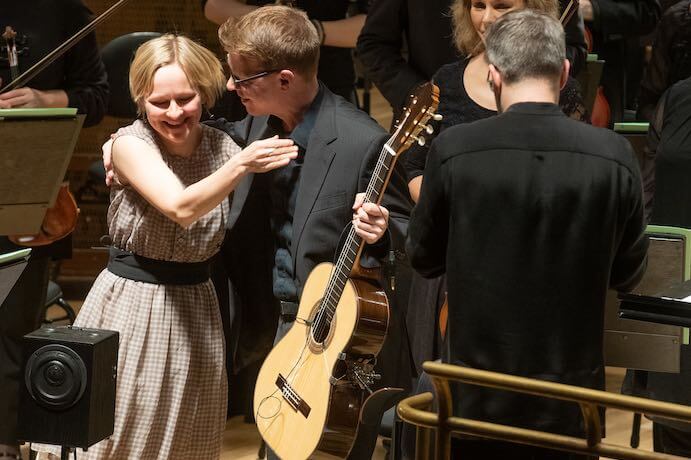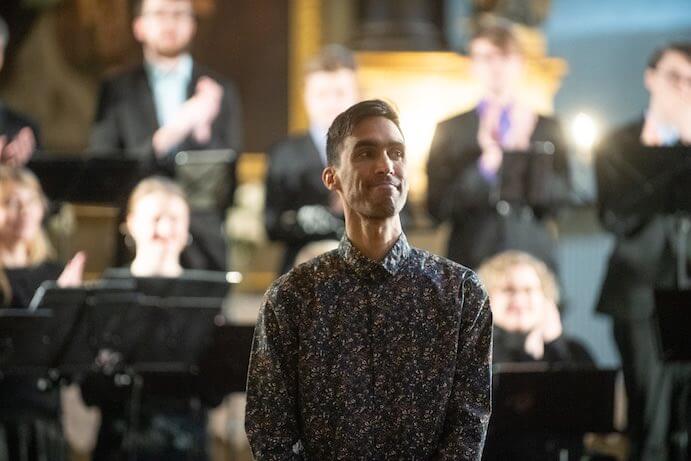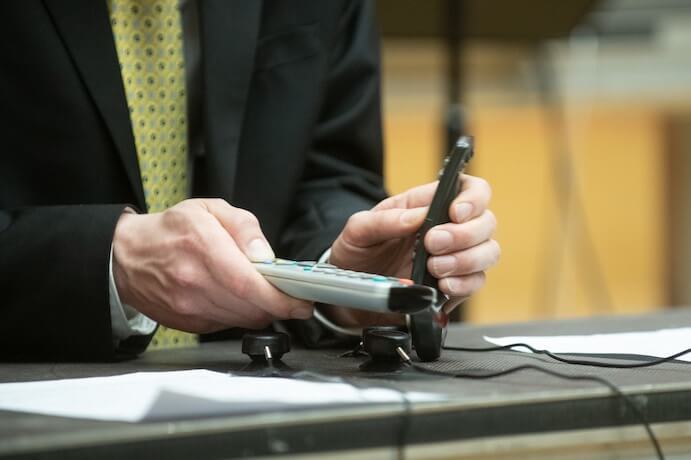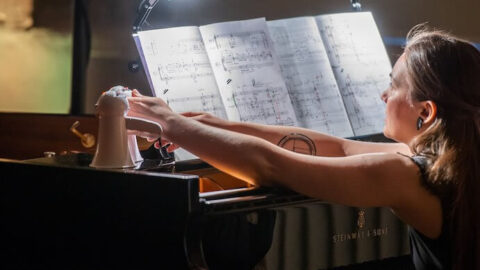At an international gathering of people, there are certain expectations one might have about the composition of the room. World Music Days, the annual festival of the International Society for Contemporary Music (ISCM), sounds like an incubator for a highly diverse group of delegates from around the world acting as musical ambassadors for their home countries. From May 2-10, World Music Days 2019 joined forces with the 40th anniversary season of Estonian Music Days to present over 100 works from nearly 50 ISCM-affiliated countries in 30 venues across Tallinn and Tartu, Estonia.
While this global convention sounds great in theory, the programming failed to meet expectations in execution—white male composers reigned supreme, with women and people of color drastically underrepresented. There was not a single work by a Black composer on the entire festival program. To my knowledge, there was not a single work by a trans, non-binary, or gender non-conforming person. This level of exclusion does not happen accidentally, so in order to figure out where the inevitable access barriers were, I had to delve into the details of how the ISCM programs World Music Days.
The multiple rounds of the nomination and selection process are as convoluted as they are mysterious with plenty of room for bias. Most member countries of the ISCM have their own “section,” i.e. ISCM-USA or ISCM-Estonia. Each section nominates up to six pieces for the annual festival, often sourced through a call for scores. If four out of those six pieces are in different genres (orchestra, choir, wind ensemble, etc.), then that section is guaranteed at least one programmed piece at World Music Days. Additionally, the ISCM puts out a call for scores, which allows individuals to apply outside of their respective country’s section. All of these works go to a panel comprised of the host country for the year and a jury appointed by the ISCM, who choose the final program.

In a perfect world, every section would submit a diverse list of nominees, but as long as white male composers are included in the nominations, the ISCM-appointed selection committee could still ultimately curate a predominantly homogeneous festival. The only way to guarantee that a section’s chosen representative would be a woman; trans, non-binary, or gender non-conforming person; or person of color, would be to only nominate those artists.
While not showcased in terms of quantity, women and people of color put out some of the highest quality work at World Music Days 2019 Tallinn. Mirjam Tally, Gabriel Dharmoo, Lotta Wennäkoski, and Violeta Dinescu made expert use of captivating timbres and experimental textures. Tally’s The Turn, performed by Norrbotten NEO, began with a wash of tamtam, bowed cymbal, string harmonics, and woodwind aeolian tones, then teased the components of this opening gesture apart to create an interplay of similar textures produced by different instruments. Collegium Musicale wove a tapestry of whistling oscillations, airy flutter tonguing, guttural outbursts, palatal clicks, hard consonants, and crackling low vocal fry in Dharmoo’s Futile Spells. As conductor Endrik Üksvärav explained to the audience mid-piece, these strange incantations were “futile attempts to connect with the invisible.”

Wennnäkoski’s Susurrus, performed by the Estonian National Symphony Orchestra and guitarist Petri Kumela, deconstructed the idea of the guitar concerto, deferring to a vocabulary of largely textural techniques. Kumela swiped at his strings and employed percussive, non-pitched strumming, which was echoed in the orchestra with col legno bowing. The moments of pitched content shone, including bowed guitar against strummed orchestral strings in a clever reversal of tone production methods. On a program dedicated to Japanese koto and Estonian kannel at the new Arvo Pärt Centre, Dinescu’s Am Berge von Yoshino proved the most effective in its use of the two instruments as a cohesive ensemble. Unison passages revealed the composite timbre of the two instruments, while the tender unfurling of a conversational dialogue featured pitch bends and dampened strings.
Vahid Jahandari, Jasna Veličković, Marianna Liik, and Nicole Lizeé excelled in their innovative use of electronics. Jahandari’s mixed media work The Vulture transformed double bass samples into bird calls, with reverberant sustains creating a barren landscape. The creaking of bow overpressure gave way to an elegiac bass soliloquy before any remnants of acoustic sound were swallowed by eerie, electronically-manipulated timbres. Veličković’s REMOTE ME featured three coils triggered by both the proximity and the contact of two remote controls. The resulting constant chugging pulse evolved into flexible polyrhythms that demonstrated the effectiveness of a simple concept executed well.

Liik’s Mets for 6.1 surround system began with ethereal voices and glistening electronics sliding into existence. Surging bass, reverb-heavy vocal lines, and rattling tones pinged around the room, evoking an otherworldly soundscape. Lizeé’s Tarantino Etudes for bass flute, soundtrack, and video distorts clips from “Kill Bill” (Vol. 1 and 2), “Reservoir Dogs,” and “Pulp Fiction” to create catchy grooves. Looping everything from the sharp inhale of snorting cocaine to the scream of getting an eye snatched out, Lizeé’s work is both comedy and a wildly impressive tour de force flute solo, performed with technical perfection by Defunensemble flutist Hanna Kinnunen.
Two of the American representatives at World Music Days 2019 were Katherine Bergman and Jessica Meyer. In Bergman’s Dream Machine for wind ensemble, singing wine glasses and bowed vibraphone usher in dark, undulating motivic fragments that glide through the ensemble. While the concept of the piece is intriguing, the performance unfortunately suffered from both reduced instrumentation and imprecise ensemble playing by the Estonian Police and Border Guard Orchestra. However, Meyer’s Ring Out Wild Bells received an outstanding performance by Vox Clamantis, who easily tackled belted solos, imitations of chiming bells, and soaring sopranos lines.
In addition to these highlights from the World Music Days portion of the programming, the works commissioned by Estonian Music Days revealed a local composition scene that is largely dominated by a network of highly-talented women composers, many of whom have either taught or studied with each other. Operating now as colleagues and friends, the social dynamic, mentorship model, and support system cultivated by these women has created a selfless environment in which it is possible for many to thrive.

Maria Kõrvits’ Öö opened a program by Una Corda, a trio of harp, harpsichord, and kannel. Kõrvits’ calculated use of sparse unison pitches with plenty of space between allowed the listener to internalize the attack, resonance, and decay of the unique ensemble. Speaking of resonance, the Estonian Philharmonic Chamber Choir gave the premiere of Helena Tulve’s Nächtliche Gesänge at the Niguliste church, which boasts a whopping seven seconds of reverb. Dark drones and meandering chromaticism laid the foundation for lyrical lines that leapt upward, only to descend back down into the timbral depths of this rewardingly complex work.
Madli Marje Sink’s Dream Sequence of an Ancient Forest for two pianos and electronics served as both the opener and the highlight of a two-piano program by Kadri-Ann Sumera and Talvi Hunt. Wooden, hollow tones palpitating from the prepared piano captured the forest in a dream; thick, knotty chords signaled an awakening; and pitch bent feedback effects produced by megaphones interlaced these two states of being. Liisa Hirsch’s Lõuend performed by the Tallinn Chamber Orchestra revealed something between texture and tone with intricate yet malleable soundscapes. Gritty violin harmonics barely sounded while double bass pedal tones thundered in Hirsch’s deft exploration of the particular timbres inherent to certain partials of the overtone series. Based on the strength and depth of these commissions, I left Tallinn wishing I could experience Estonian Music Days separate from the frenzied schedule of World Music Days.

So who is World Music Days for, and what purpose does it serve? The ISCM has the capacity to break contemporary music out of its often insular space by bringing an international festival of contemporary artists to a new city every year. However, the logistics of the programming were anything but accessible for audience members. World Music Days unfolded at an uncomfortably frenetic pace, with concerts lasting an average of 90 minutes or more, sometimes bleeding into the next event, and requiring audiences to run from one venue to the next with no time for meals. Every performance I attended was a traditional sit-down concert in a fairly standard performance space that adhered to the typical pageantry of concert music—no prefatory remarks, no engagement with the audience, just a one-way dialogue.
If World Music Days isn’t primarily for outside audiences, is the goal of the festival to simply allow composers to gather and have their works played for each other? This seems short-sighted and will only push the ISCM toward becoming obsolete, especially if future festivals continue to exclude and marginalize entire communities of artists. Correcting these inequities starts with putting socially conscious people in leadership positions. When the ISCM Executive Committee met at this year’s festival, Glenda Keam was voted the first woman president of the organization in its 97-year history. Frank Oteri, Co-Editor of NewMusicBox and tireless composer advocate, was voted Vice President. With these two at the helm, there is hope for change on the horizon.
























